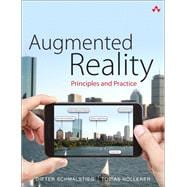
Note: Supplemental materials are not guaranteed with Rental or Used book purchases.
Purchase Benefits
What is included with this book?
Dieter Schmalstieg is full professor and head of the Institute for Computer Graphics and Vision at Graz University of Technology (TUG), Austria. His current research interests are augmented reality, virtual reality, real-time graphics, 3D user interfaces, and visualization. He received Dipl.-Ing. (1993), Dr. techn. (1997) and Habilitation (2001) degrees from Vienna University of Technology. He is author and co-author of over 200 peer-reviewed scientific publications, associate editor of IEEE Transactions on Visualization and Computer Graphics, member of the editorial advisory board of computers & graphics and of Springer Virtual Reality, member of the steering committee of the IEEE International Symposium on Mixed and Augmented Reality, chair of the EUROGRAPHICS working group on Virtual Environments (1999-2010), advisor of the K-Plus Competence Center for Virtual Reality and Visualization in Vienna and member of the Austrian Academy of Science. In 2002, he received the START career award presented by the Austrian Science Fund. In 2012, he received the IEEE Virtual Reality technical achievement award for seminal contributions to the field of Augmented Reality. Since 2008, he is also director of the Christian Doppler Laboratory for Handheld Augmented Reality.
Tobias Höllerer is Professor of Computer Science at the University of California, Santa Barbara, where he leads the Four Eyes Laboratory, conducting research in the four I's of Imaging, Interaction, and Innovative Interfaces. Dr. Höllerer holds a Diplom in informatics from the Technical University of Berlin as well as an MS and PhD in computer science from Columbia University. He is a recipient of the US National Science Foundation's CAREER award, for his work on "Anywhere Augmentation", enabling mobile computer users to place annotations in 3D space wherever they go. He has been named an ACM Distinguished Scientist in 2013. Dr. Höllerer is author of over 150 peer-reviewed journal and conference publications in the areas of augmented and virtual reality, information visualization, 3D displays and interaction, mobile and wearable computing, and social computing. Several of these publications have been selected for Best Paper or Honorable Mention awards at such venues as the IEEE International Symposium on Mixed and Augmented Reality (ISMAR), IEEE Virtual Reality (VR), ACM Virtual Reality Software and Technology, ACM User Interface Software and Technology, ACM MobileHCI, IEEE SocialCom, and IEEE CogSIMA. Dr. Höllerer is an associate editor of IEEE Transactions on Visualization and Computer Graphics, and among his many organizational roles for scientific conferences he served as program chair for IEEE VR 2015, ICAT 2013, IEEE ISMAR 2010 and 2009, as general chair of IEEE ISMAR 2006, and as member of the steering committee of IEEE ISMAR.
Chapter 1. Introduction
Chapter 2. Displays
Chapter 3. Tracking
Chapter 4. Computer Vision for Augmented Reality
Chapter 5. Calibration and Registration
Chapter 6. Visualization Techniques
Chapter 7. Interaction Techniques
Chapter 8. Modeling and Annotation
Chapter 9. Authoring
Chapter 10. Navigation
Chapter 11. Collaboration
Chapter 12. Software Architecture
Chapter 13. Programming with Vuforia
Chapter 14. Conclusion and Outlook
The New copy of this book will include any supplemental materials advertised. Please check the title of the book to determine if it should include any access cards, study guides, lab manuals, CDs, etc.
The Used, Rental and eBook copies of this book are not guaranteed to include any supplemental materials. Typically, only the book itself is included. This is true even if the title states it includes any access cards, study guides, lab manuals, CDs, etc.